|
||||||
|
BRACHYPODIUM. Bromes and Tor-grass. [Poaceae] |
|
Three native species of Brachypodium are recorded in Britain - Stiff Brome (B. distachyon), Perennial Tor-grass (B. pinnatum) and False Brome (B. sylvaticum). Twenty-three British miners are recorded on Brachypodium. The gelchiid Helcystogramma rufescens spins grass blades and feeds inside the spiral spinning, causing whitening of the grass blade tip. A key to the European miners recorded on Brachypodium is provided in Bladmineerders van Europa. Nearly 100 British miners or possible miners are recorded on grasses in Britain. It is recommended that adults of all miners on grasses be reared to be certain of their identity. |
Key for the identification of the known mines of British |
Note: Diptera larvae may live in a corridor mine, a corridor-blotch mine, or a blotch mine, but never in a case, a rolled or folded leaf, a tentiform mine or sandwiched between two more or less circular leaf sections in later instars. Pupation never in a cocoon. All mining Diptera larvae are leg-less maggots without a head capsule (see examples). They never have thoracic or abdominal legs. They do not have chewing mouthparts, although they do have a characteristic cephalo-pharyngeal skeleton (see examples), usually visible internally through the body wall. The larvae lie on their sides within the mine and use their pick-like mouthparts to feed on plant tissue. In some corridor miners frass may lie in two rows on alternate sides of the mine. In order to vacate the mine the fully grown larva cuts an exit slit, which is usually semi-circular (see Liriomyza huidobrensis video). The pupa is formed within the hardened last larval skin or puparium and as a result sheaths enclosing head appendages, wings and legs are not visible externally (see examples). See Key to non-Diptera. |
1a > Leaf-miner: Pupation internal. |
1b > Leaf-miner: Pupation external. |
2a > Leaf-miner: Long, narrow, whitish mine. Pupation internal (Spencer, 1976: 453); anterior spiracles projecting through the epidermis. Whitish, upper-surface, rather narrow corridor with comparatively large frass grains that are laying further apart than their diameter. Pupation within the mine. The anterior spiracles of the orange-brown puparium penetrate the epidermis. |
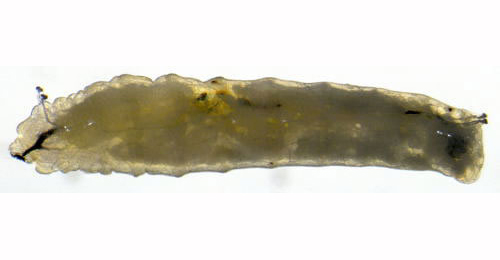 Chromatomyia nigra larva, lateral Image: © Willem Ellis (Bladmineerders van Europa) |
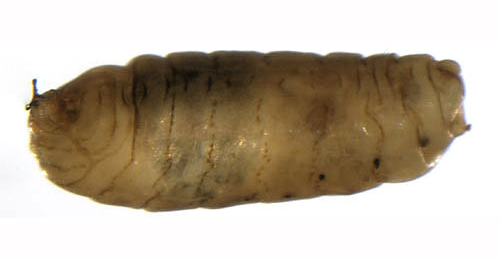 Chromatomyia nigra pupa, lateral Image: © Willem Ellis (Bladmineerders van Europa) |
|
Chromatomyia nigra (Meigen, 1830) [Diptera: Agromyzidae]. |
2b > Leaf-miner: Narrow whitish mine, with frass in distinct black lumps. Pupation internal |
|
Chromatomyia fuscula (Zetterstedt, 1838) [Diptera: Agromyzidae]. |
2c > Leaf miner: A substantial linear mine. Pupation internal; posterior spiracles projecting through the epidermis (Spencer, 1976: 449). Elongated, shallow, upper-surface or lower-surface blotch, not infrequently several in one leaf. Frass in strings or pearl chains. Pupation within the mine. |
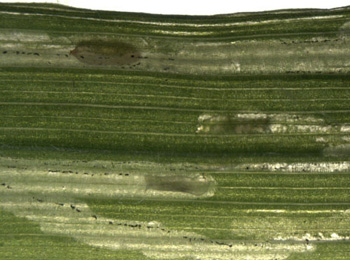 Mine of Chromatomyia milii on Holcus lanatus Image: © Willem Ellis (Bladmineerders van Europa) |
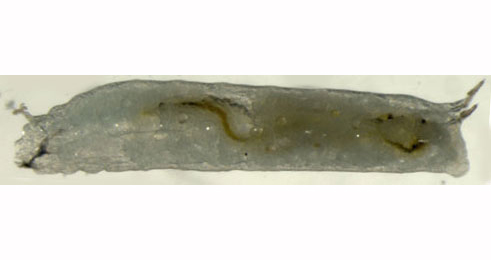 Chromatomyia milii larva, lateral Image: © Willem Ellis (Bladmineerders van Europa) |
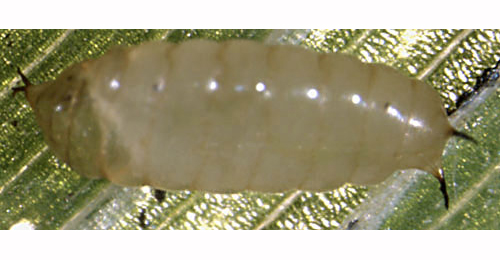 Chromatomyia milii larva, dorsal Image: © Willem Ellis (Bladmineerders van Europa) |
|
Chromatomyia milii (Kaltenbach, 1864) [Diptera: Agromyzidae]. |
2d > Leaf-miner: Irregular mine, locally shallow, elsewhere much deeper, giving it a mottled appearance. In broadleaved plants the mine often begins as a blotch with stellate extensions, but sometimes as a very fine, shallow corridor. In grasses the mine often begins in the leaf sheath. The frass is very fine-grained, initially scattered, later in aggregates. |
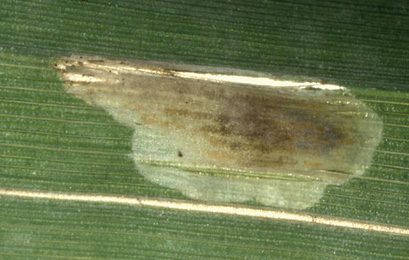 Mine of Hydrellia griseola on Glyceria fluitans Image: © Willem Ellis (Bladmineerders van Europa) |
|
Hydrellia griseola (Fallén, 1813) [Diptera: Ephydridae]. |
2e > Leaf-miner: Larvae feed singly, forming an upper surface linear-blotch mine. Pupation either internal or external, with the puparium loosely glued to the leaf (Spencer, 1976: 91). Oviposition near the leaf margin, at some distance from the leaf tip. From there develops an upper-surface corridor-blotch. At first the mine ascends as a narrow corridor towards the leaf tip, then the direction turns and the mine, steadily widening, descends in the direction of the leaf base. Frass irregular, in rather coarse grains. Larva solitary. Pupation mostly outside the mine; in that case the puparium often sticks to the leaf. |
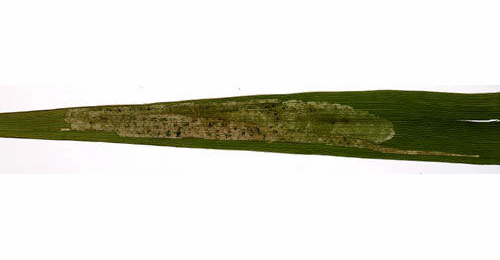 Mine of Agromyza albipennis on Phalaris arundinacea Image: © Willem Ellis (Bladmineerders van Europa) |
|
Agromyza albipennis Meigen, 1830 [Diptera: Agromyzidae]. |
3b > Leaf-miner: More than one larva in mine. |
4a > Leaf-miner: Larvae feed singly, forming an upper surface linear-blotch mine. Pupation either internal or external. Puparium reddish, brown or black, frequently adhering to leaf near end of mine. |
 Mine of Agromyza albipennis on Phalaris arundinacea Image: © Willem Ellis (Bladmineerders van Europa) |
|
Agromyza albipennis Meigen, 1830 [Diptera: Agromyzidae]. |
4b > Leaf-miner: Larvae feed singly, forming greenish mine, initially running towards apex of leaf before turning back down and developing into a broad blotch. Puparium reddish brown. |
|
Agromyza rondensis Strobl, 1900 [Diptera: Agromyzidae]. |
4c > Leaf-miner: Larvae feeding singly, forming a long, widening mine on the upper surface of the leaf, which is generally limited to one side of the leaf. Pupation external, puparium glued to the leaf near the end of the mine (Spencer, 1976: 128). Broad corridor, generally beginning near the leaf margin or close to the leaf tip. Most of the times the mine remains at one side of the midrib. The mine is upper-surface, but has some full depth, translucent spots here and there. Frass in rather regularly scattered grains. Pupation outside the mine. According to Dempewolf (2004a) only the male genitalia enable a reliable discrimination from A. abipennis and A. graminicola. |
|
Agromyza nigripes Meigen, 1830 [Diptera: Agromyzidae]. |
5a > Leaf-miner: Normally several larvae feed together. Pupation in the mine. Puparium shining black (Spencer, 1976: 198). Broad elongated blotch. Frass greenish. Larvae generally communal. Pupation within the mine. The black puaria are individially anchored within the mine with a silken thread attached at their rear end. Distinguishable from C. incisa only by means of the larva. |
|
Cerodontha pygmaea (Meigen, 1830) [Diptera: Agromyzidae]. |
5c > Leaf-miner: Upper-surface, unusually short corridor (ca. 4 cm). Puparium brown |
|
Liriomyza pusio (Meigen, 1830) [Diptera: Agromyzidae]. |
5d > Leaf-miner: Long upper-surface corridor usually containing several larvae that graze shoulder to shoulder from the leaf tip downwards. Pupation outside the mine. Mines and larvae are indistinguishable from those of A. nigrella. |
|
Agromyza mobilis Meigen, 1830 [Diptera: Agromyzidae]. |
|
Key for the identification of the known mines of British |
Note: The larvae of mining Coleoptera, Hymenoptera and Lepidoptera may live in a corridor mine, a corridor-blotch mine, a blotch mine, a case, a rolled or folded leaf, a tentiform mine or sandwiched between two more or less circular leaf sections in later instars. Larva may pupate in a silk cocoon. The larva may have six legs (although they may be reduced or absent), a head capsule and chewing mouthparts with opposable mandibles (see video of a gracillarid larva feeding). Larvae of Hymenoptera and Lepidoptera usually also have abdominal legs (see examples). Frass, if present, never in two rows. Unless feeding externally from within a case the larva usually vacates the mine by chewing an exit hole. Pupa with visible head appendages, wings and legs which lie in sheaths (see examples). |
1a > Leaf-miner: Tufted hair-grass and blue moor-grass are the main foodplants, the larvae forming gallery mines. Gradually widening corridor, running either upwards or down. All frass is deposited in the earliest part of the mine. Often 2-3 larvae in a mine; in grasses with broad leaves sometimes more than one mine in a leaf. |
|
Elachista adscitella Stainton, 1851 [Lepidoptera: Elachistidae]. |
1b > Leaf-miner: The larva mines from the grass tip downwards and the mine occupies half or the whole of the leaf blade width. A whitish blotch is formed with characteristic narrow streaks of frass. Full depth blotch, slightly inflated, descending from the leaf tip, occupying half or the entire width of the blade. The larva may move and make a new mine elsewhere. In the latter case the mines are fairly short; otherwise an entire blade may be mined out. Frass in a some narrow greyish brown streaks. Pupation outside the mine. |
|
Elachista albifrontella (Hübner, 1817) [Lepidoptera: Elachistidae]. |
1c > Leaf-miner: Corridor widening while descending from the tip of the leaf. The mine is unusual because the sides are very irregularly scalloped out. Moreover, the mine is not evenly transparent, but rather yellowish green and motly, because the larva leaves patches of parenchyma uneaten, and does not feed full depth. Frass in a few irregular, interrupted length lines. Often 2-3 larvae in a mine. The larvae hibernate in the centre of the mine; after winter they leave their mine and pupate. |
|
Elachista apicipunctella Stainton, 1849 [Lepidoptera: Elachistidae]. |
1d > Leaf-miner: In autumn the larva makes a narrow corridor a few cm in length, in which it hibernates. In March it moves to a new leaf. Here a transparent, full depth mine is made that descends from the leaf tip, and occupies the entire width of the blade. Most frass is concentrated in the oldest, highest, part of the mine. The larva may leave its mine and restart elsewhere. Pupation outside the mine |
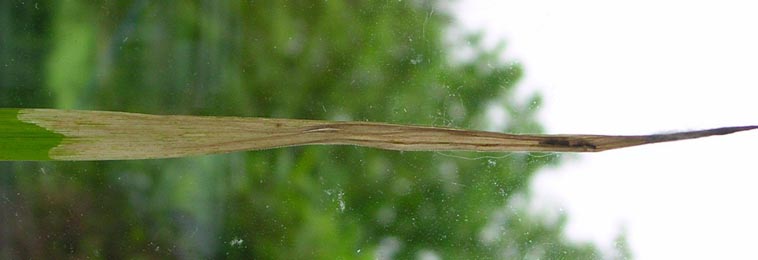 Mine of Elachista argentella on Dactylis glomerata Image: © Ben Smart (British leafminers) |
|
Elachista argentella (Clerck, 1759) [Lepidoptera: Elachistidae]. |
1e > Leaf-miner: Mine a descending and widening corridor, in the end an elongate blotch that may occupy the entire width of the leaf. The mine contracts somewhat, narrowing the leaf. Frass in some elongate lumps in the centre of the mine. |
|
Elachista bisulcella (Duponchel, 1843) [Lepidoptera: Elachistidae]. |
1f > Leaf-miner: The larva mines downwards and forms an irregular mine with a silken tube in the centre, which is mixed with frass. Mine transparent (therefore conspicuous), generally descending from the leaf tip. Over the entire length of the mine stretches a central silken tube, in which the larva can retreat and can move quickly up or down. The tube also contains the frass. The larva feeds laterally from the tube, which makes the sides of the mine very irregular. |
|
Elachista gangabella Zeller, 1850 [Lepidoptera: Elachistidae]. |
1g > Leaf-miner: Long, narrow, white corridor, descending from close to the leaf tip to the leaf base or even stem. Frass in an inconspicuous grey line. From the stem the larva may enter a new leaf (Steuer, 1987a; Bland, 1996a). |
|
Elachista luticomella Zeller, 1839 [Lepidoptera: Coleophoridae]. |
1h > Leaf-miner: Larva makes a large whitish blotch and mines the leaf downwards. The frass tends to be deposited in the upper part of the mine. Oviposition usually not far from the leaf tip. From there descends an irregular blotch mine. Hering (1957a) describes the mine as flat and quite shallow, giving it a greenish, rather than whitish appearance. Frass initially in the oldest, upper part of the mine, later in strings. The larva can leave its mine and restart elsewhere. Normally only one larva per mine, but sometimes two or even three mines in a leaf. Pupation outside the mine. |
|
Elachista maculicerusella (Bruand, 1859) [Lepidoptera: Elachistidae]. |
1i > Leaf-miner: Initially a narrow brownish mine with blackish frass at its base, then moves to another leaf, forming a broader mine. Both mines can pucker the blade. |
|
Elachista obliquella Stainton, 1854 [Lepidoptera: Elachistidae]. |
1j > Leaf-miner: Mines downwards from leaf tip to stem. Makes a long narrow yellowish mine. May be up to four larvae in one leaf. Long narrow yellowish corridor, descending from the leaf tip to its base; at times 3-4 larvae in a leaf. Often several larvae in a communal mine. Pupation outside the mine. |
|
Elachista stabilella Stainton, 1858 [Lepidoptera: Elachistidae]. |
1k > Leaf-miner: The larva creates a long narrow mine in the blade. Mine fairly translucent. It starts as a narrow corridor, running towards the leaf tip, but this almost invariably is overrun be a later, broad, descending corridor. The centre of the mine contains a vertical tube made of loose silk, in which the larva can quickly move up or down, and in which also most frass gets trapped. The sides of the mine are smooth (contrary to E. gangabella). Mines are difficult to find, because the leaves are wilting when larvae are present. |
|
Elachista subalbidella Schläger, 1847 [Lepidoptera: Elachistidae]. |
1l > Leaf-miner: The larva feeds internally on a leaf of False Brome, forming a blister-like mine. At first a narrow ascending corridor. The direction reverses and the mine develops into a broad, greenish, inconspicuous blotch, reminiscent of a tentiform mine, 5-8 cm long. Pupation external. |
|
Elachista subocellea (Stephens, 1834) [Lepidoptera: Elachistidae]. |
1m > Leaf-miner: In autumn the larva makes a long, somewhat blistered, slightly transparent corridor. In spring it mines the basal leaves that lie on the ground. These mines are swollen, clouded green, opaque, and the mined tips of the leaves are puckered and shrunken, filled with frass. |
|
Elachista unifasciella (Haworth, 1828) [Lepidoptera: Elachistidae]. |
| Last updated 01-Jul-2019 Brian Pitkin | ||
